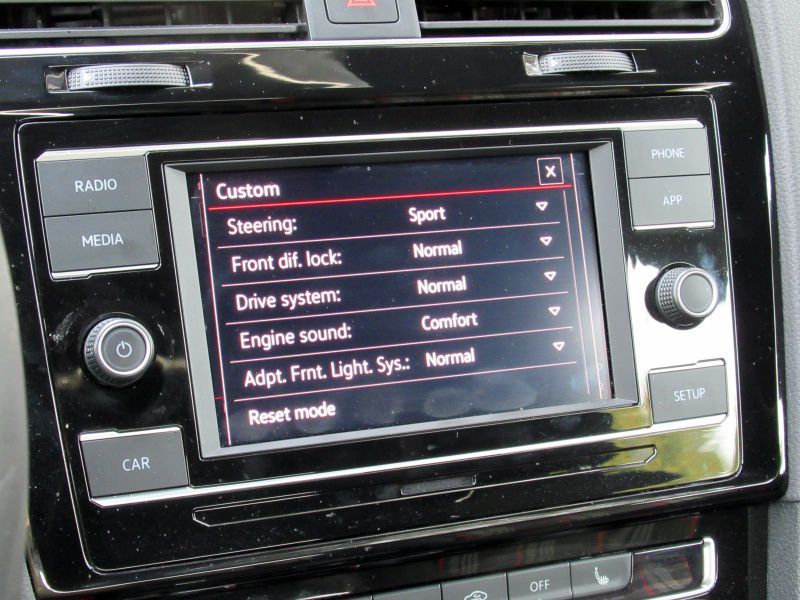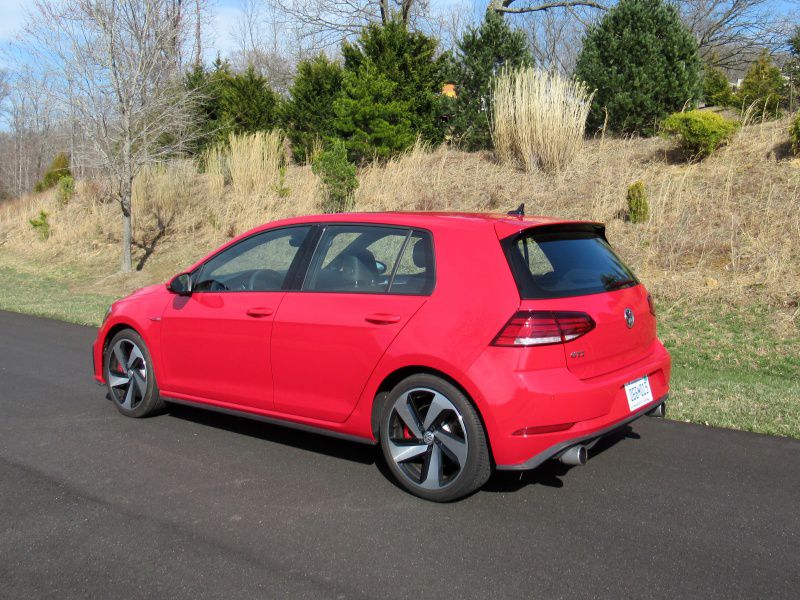Recent Articles
Popular Makes
Body Types
2019 Volkswagen Golf GTI Road Test and Review

2019 Volkswagen GTI Red Front Three Quarter BH ・ Photo by Brady Holt
To some folks, the idea of a sports car is inseparable from a low-slung two-door body and a boisterously powerful engine. They’re looking for gorgeous styling and maximum performance. They’re following their hearts as far as how the car looks, and their heads as far as the spec sheet.
The 2019 Volkswagen Golf GTI is a different kind of sporty car. A higher-performance version of the humble Golf, the GTI skews toward artful refinement rather than on-paper dominance. And its functional five-door hatchback body is shaped more like a hiking boot than like a Ferrari. The result is a glorious driving experience from a car that’s perfectly suited to everyday life. If that sounds like your style of car, keep reading to learn more about today’s evolution of this classic Volkswagen.
Relatively Affordable
In simple terms of horsepower per dollar, the 2019 Volkswagen Golf GTI isn’t a screaming bargain. But for a premium-feeling sporty car, it’s a pretty good deal. Prices start at $27,595 for the base S model, which has standard features including such luxuries as 18-inch alloy wheels, heated front seats, and rain-sensing windshield wipers, plus tech features like Bluetooth connectivity, and Android Auto and Apple CarPlay smartphone integration.
The next level up is the new Rabbit Edition ($28,895), which adds some unique aesthetic details as well as keyless entry and starting, automatic emergency braking, blind-spot monitoring, and LED headlights. The SE ($31,795) adds leather upholstery, a sunroof, and a larger infotainment touchscreen. The top Autobahn model ($35,995) adds a few everyday features — a power driver’s seat, an auto-dimming rearview mirror, and automatic climate control — plus a Fender sound system, adaptive cruise control, lane-keeping assistance, parking sensors, a self-parking feature, and an adaptive suspension system.

Photo by Brady Holt
Hot-Hatch Heritage
The Volkswagen GTI originated the “hot hatch” segment that adds power and handling capabilities to humble economy hatchbacks. The first GTI hit the market in 1976, and later it came to the U.S. as a 1983 model. It’s spawned many imitators over the years, but the GTI has remained true to its original form. It still is relatively upright and boxy, with a near-vertical rear end, while even most five-doors today are longer, lower, and more elaborately decorated. Volkswagen recently added red highlights to the headlamps for some visual spice up front.
One cue that comes straight out of the ’70s is the GTI’s plaid cloth upholstery, which adds loads of character to the VW’s interior on the base S and the tested Rabbit Edition. (The SE and Autobahn have more typical single-tone leather.) The Rabbit Edition — named for the Golf’s former name in the U.S. market — adds several Rabbit badges to the exterior and interior, along with exclusive black wheels.

Photo by Brady Holt
Audi-Like Driving Experience
To some critics, the GTI is an expensive Golf. But we prefer to think of it as a bargain-priced Audi. The Golf and GTI are in fact mechanical cousins of the Audi A3 compact sedan, and the connection is clear in their ride and handling. Even the base Golf exhibits excellent suspension composure, while the GTI is tuned more firmly for improved handling response. It also boasts a limited-slip differential that’s newly standard for 2019.
Drive the GTI gently and it’s an easygoing Golf, with a smooth ride, quiet cabin, and light but natural-feeling steering. But the GTI also responds willingly when you push it harder, and you can customize its driving modes, including adjustments like tightening up the steering for extra-quick responses. The chassis's luxury-grade composure keeps pace with the fast steering, too. Furthermore, if you’ll take your GTI to the racetrack or an autocross course, an “ESC Sport” mode dials back its electronic stability control interventions. At the same time, the Golf GTI feels less frenetic and more refined than most affordable sporty cars.

Photo by Brady Holt
Zippy, but Not Overpowered
The Volkswagen Golf GTI saw a horsepower bump this year, from 220 hp to 228. That won’t lead to a first-place finish on the spec sheet, but its power is more than agreeable on the road. There’s also a bigger difference now from the standard Golf, as VW decided this year to sacrifice some of the base Golf’s strong acceleration to improve its fuel economy. The GTI zips forward eagerly, but it doesn’t slam you back in your seat — for that experience, VW would like you to upgrade to the 288-hp Golf R for $40,395. The standard six-speed manual transmission has pleasant throws and well-spaced ratios, and we loved the shift knob’s golf-ball texture. A seven-speed dual-clutch automatic also is available, replacing last year’s six-speed unit.
The EPA rates the GTI at 24 mpg in the city, 32 mpg on the highway, and 27 mpg overall with the manual, while the automatic manages 25 mpg city and 31 mpg highway. The EPA ratings are based on regular-grade fuel, though VW recommends premium for the full 228 horsepower. The tested GTI manual averaged an excellent 33 mpg in mixed driving.

Photo by Brady Holt
Comfortable and High-Quality
Every 2019 Volkswagen Golf, the GTI included, has a high-quality interior with rich materials and solid assembly quality. Even on the GTI, the design is subtle and understated rather than flashy — except for the plaid upholstery, that is. Controls are generally user-friendly, and the touchscreen infotainment system (6.5 inches on the S and Rabbit Edition, 8 inches on the SE and Autobahn) supports Android Auto and Apple CarPlay.
A big difference between the standard Golf and the GTI is the front seats. The Golf has pleasant but ordinary seats, while the GTI’s are an enthusiast’s dream. They’re generously bolstered to hold you in place when you take a corner fast, yet also wonderfully comfortable in everyday use. And at the risk of being repetitive, we love the plaid.

Photo by Brady Holt
Sporty Yet Spacious
The 2019 Volkswagen Golf GTI’s boxy shape results in useful interior space. The rear seat doesn’t have a ton of surplus legroom, but the cushion is comfortable for two adults. Unlike in many small cars, there’s no shortage of rear headroom. And the GTI earned the highest Insurance Institute for Highway Safety score for the ease of installing a child seat.
Cargo space also is respectable: 23 cubic feet of luggage volume behind the rear seat, and 53 cubic feet with the rear seat folded down. That's better than many small SUVs. The GTI isn’t as long as most compact hatchbacks, which reduces the floor space available behind the rear seat, but the boxy shape makes it easier to carry bulky items.

Photo by Brady Holt
Generous Safety
The 2019 Volkswagen Golf GTI performed very well in crash tests from the National Highway Traffic Safety Administration and the Insurance Institute for Highway Safety. It earned a top five-star overall score from NHTSA, and the highest Good rating in all but one IIHS test. (That last one, the passenger-side small-overlap frontal impact, is the newest and most challenging test from IIHS; the GTI earned the second-highest score of Acceptable.)
For 2019, all but the base GTI S come standard with a forward collision warning, automatic emergency braking, and a blind-spot monitoring system with a rear cross-traffic alert; they’re optional on the S, too. The top Autobahn model adds a lane-departure warning with lane-keeping automatic steering corrections.

Photo by Brady Holt
Varied Competition
The GTI faces a diversity of competition among sporty yet practical cars. Perhaps the most similar is the MINI Clubman S, another premium-feeling, extra-agile European hatchback. It’s about the same size as the GTI, too, despite the Mini name. The GTI offers more relaxed comfort when you want it, though, along with lower prices and more conventional looks. The GTI also competes against a pair of sporty sedans: the Honda Civic Si and Subaru WRX. The Civic Si is spacious and affordable, but the GTI has more premium features and offers an automatic transmission. The WRX boasts standard all-wheel drive, but lacks the GTI’s luxury feel.
You might also consider other VW/Audi models. The standard Golf is fun to drive for less money than the GTI, but most trim levels now have 147 horsepower instead of the GTI’s 228. The upcoming Jetta GLI sedan offers the same mechanicals as the GTI hatchback, for less money. The pricey Golf R offers extra-strong acceleration and all-wheel drive. And the Audi A3 sedan offers a similar driving experience to the GTI, plus Audi styling inside and out, at still-attainable prices.

Everyday Enjoyment
The 2019 Volkswagen Golf GTI is one of the most multi-talented vehicles on the market. It’s smooth and quiet when you want it to be. It’s well-finished and fully featured. It’s usefully spacious without being bulky. And as long as you prefer everyday driving enjoyment over maximum racetrack performance, it’s an absolute hoot to drive.
Some buyers would rather pick a car with more power, more flashy looks, or even higher handling limits. But the GTI is special in that it happily adjusts to however you want to drive, whether aggressively or gently. It’s agreeably comfortable, useful, safe, and luxurious, while still offering a delightful driving experience — all for prices that start comfortably below $30,000. If that combination sounds like your type of sporty car, don’t miss the GTI.

Photo by Brady Holt